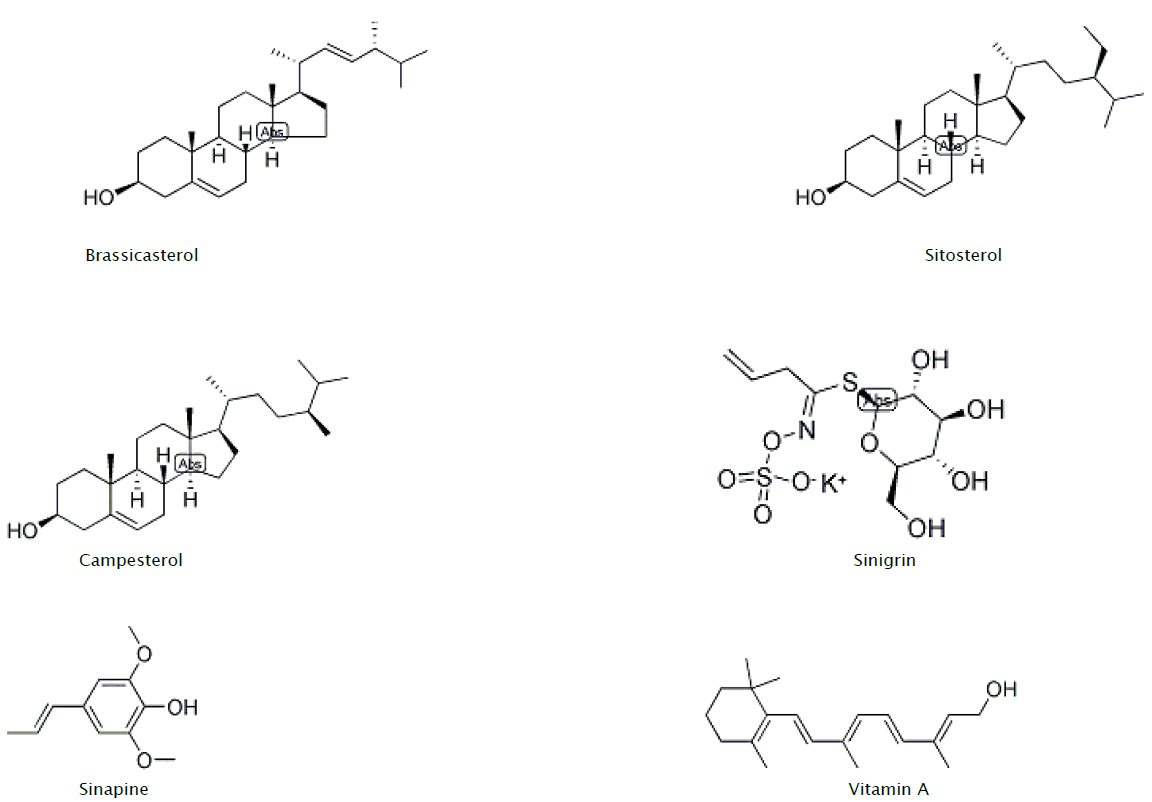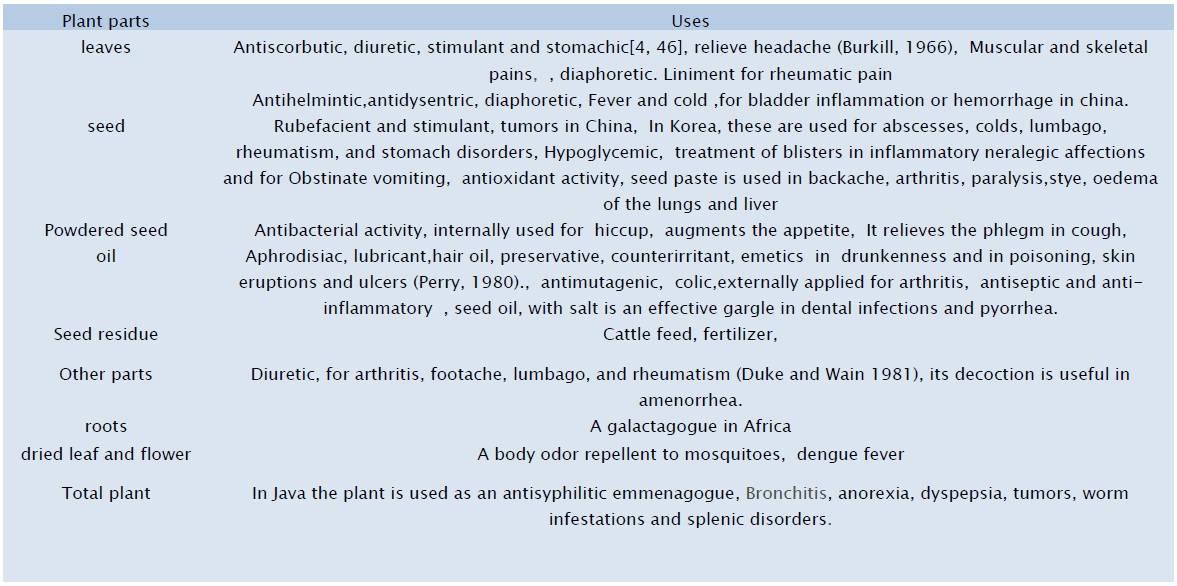ISSN: 2320-0189
ISSN: 2320-0189
Mishra Anuradha*1, Dash Pragyandip2, Murthy PN3, Siddique HH1, and Kushwaha Poonam1
1Integral University, Kursi Road, Lucknow, Uttar Pradesh, India
2Amity Institute of Pharmacy, Amity University, Lucknow, Uttar Pradesh, India
3Royal College of Pharmacy and Health Sciences, Berhampur, Odisha, India
Received date: 17 August 2012 Accepted date: 15 October 2012
Visit for more related articles at Research & Reviews: Journal of Botanical Sciences
The botanical name of rajika is Brassica juncea and it belongs to family Brassicaceae. The mustard made from the seeds of the Brassica juncea is called brown mustard. which are used for medicinal purpose as well as food, since centuries. Brown mustard plant produces tiny yellow colored flowers, which almost cover the plant. Reported to be anodyne, aperitif, diuretic, emetic, rubefacient, and stimulant, aparfrom the reported use plant is having application in allied field such as kitchen, phytomedicine, general medication for its medicinal value.
Brassica juncea, rai seed, medicinal uses ,chemical composition
Brassica is one of the most ancient spices. It has 3 varieties namely black, brown and white. Brown mustard is largely cultivated. Brown mustard plant produces tiny yellow colored flowers, which almost cover the plant. The black mustard plant normally grows to a height of 10 feet. White mustard is the most mild among all the varieties of mustard. Mustard Seed has a fresh aroma and slightly biting flavor but when the seeds are dried they do give any fragrance. The leaves, the seeds, and the stem of this mustard variety are edible. The plant appears in some form in African, Indian, Chinese, Japanese, and Soul food cuisine[1-3].
The mustard made from the seeds of the Brassica juncea is called brown mustard. which are used for medicinal purpose as well as food, since centuries. Ayurvedic Samhita have vividly described the properties and medicinal uses of these two varieties separately. Though they are two separate herbs, more or less, their properties are similar. Charaka has categorized the white variety as asthapanopaga – adjunct to decoction enemas and the black variety as kandughna – antipruritic [6-7]
The plant is cultivated throughout India, especially in Bihar, Bengal and Uttar Pradesh. It is a large branching annual, growing up to 0.6-1 meter in height. The leaves broadly ovate, coarsely dentate, the lowest ones lyrate and slightly hispid whereas, the upper ones lanceolate, all stalked, dark green in colour. The flowers in corymbose racemes, stalked, bright yellow. The fruits, siliqua, 2.5-5 cm long, oblong-linear. The seeds are brownish-red, tiny.[4]
The botanical name of rajika is Brassica juncea and it belongs to family Brassicaceae. The white variety – sarsapa is botanically known as Brassica alba. The seeds of rajika contain 20%-25% stable oil. Brassilexin isolated from leaves and its structure elucidated. Trans – Ocimene identified as a major component along with allylisothiocyanate.
Rajika is pungent and bitter in taste, pungent in the post digestive effect and has hot potency. It alleviates vata and kapha doshas. It possesses light and sharp attributes. It is emetic, digestant, anti-inflammatory and irritant in properties. It is used in the diseases like abdominal pain, anorexia, worms, and diseases of the spleen, tumours and wounds.[5]
It is commonly known as Rai, /Indian mustard It is a Perennial herb, usually grown as an annual or biennial, up to 1 m or more tall; branches long, erect or patent; lower leaves petioled, green, sometimes with a whitish bloom, ovate to obovate, variously lobed with toothed, scalloped or frilled edges, lyrate-pinnatisect, with 1–2 lobes or leaflets on each side and a larger sparsely setose, terminal lobe; upper leaves subentire, short petioled, 30–60 mm long, 2–3.5 mm wide, constricted at intervals, sessile, attenuate into a tapering, seedless, short beak 5–10 mm long. Rooting depth 90–120 cm. Seeds about 5,660–6,000 per 0.01 kg (1/3 oz).[7]
Biological Name:
Brassica juncea, Brassica campestris, Brassica nigra
Other Names:
English - Black mustard seed or Brown mustard seed
Hindi - Rai or Lal sarsu
Gujarati - Rai
Marathi - Mohari
Punjabi - Rai
Tamil - Kadugu
Telugu - Avalu
Classification
Brassica juncea (L.) Czern.

Chemical Composition
Mustard greens are high in Vitamin A and C, and iron; a cupful (140 gm) providing an adult with ca 60% of his recommended daily Vitamin A requirement, all the Vitamin C requirement and about one-fifth the iron. Per 100 g, the leaf is reported to contain 24 calories, 91.8 g H2O, 2.4 g protein, 0.4 g fat, 4.3 g total carbohydrate, 1.0 g fiber, 1.1 g ash, 160 mg Ca, 48 mg P, 2.7 mg Fe, 24 mg Na, 297 mg K, 1825 g -carotene equivalent, 0.06 mg thiamine, 0.14 mg riboflavin, 0.8 mg niacin, and 73 mg ascorbic acid. Per 100 g, the root is reported to contain 38 calories, 85.2 g H2O, 1.9 g protein, 0.3 g fat, 8.8 g total carbohydrate, 2.0 g fiber, 3.8 g ash, 111 mg Ca, 65 mg P, 1.6 mg Fe, 447 mg K, 45 g -carotene equivalent, 0.05 mg thiamine, 0.12 mg riboflavin, 0.7 mg niacin, and 21 mg ascorbic acid. Per 100 g, the seed is reported to contain 6.2 g H2O, 24.6 g protein, 35.5 g fat, 28.4 g total carbohydrate, 8.0 g fiber, and 5.3 g ash. It also contains Brassilexin Seed sterols contain 19.2% brassicasterol (9.1% esterified), 23.6% free campesterol (34.0% esterified), 57.2% sitosterol (55.2% esterified), 1.7% esterified -5-avenasterol, and a trace of -7-stigmasterol. Contains the glucosinolate sinigrin (potassium myronate) and the enzyme myrosin (myrosinase); sinapic acid; sinapine (sinapic acid choline ester); fixed oils (25 to 37%) consisting mainly of glycerides of erucic, eicosenoic, arachidic, nonadecanoic, behenic, oleic, and palmitic acids, among others; proteins (e.g., globulins); and mucilage (Leung, 1980). Sinigrin on hydrolysis by myrosin (myrosinase) yields allyl isothiocyanate, glucose, and potassium bisulfate. Allyl isothiocyanate is volatile; its yield from B. juncea is 0.25 to 1.4% (usually ca 0.9%). Other minor volatile components that are also set free by enzymatic hydrolysis include methyl, isopropyl, sec-butyl, butyl, 3-butenyl, 4-pentenyl, phenyl, 3-methylthiopropyl, benzyl, and -phenylethyl isothiocyanates. [4,8]Allyl isothiocyanate is irritant, rubefacient and vesicant. It is also lachrymatory and has counterirritant properties when greatly diluted (e.g., 1 in 50). It should not be tasted or inhaled when undiluted. It is one of the most toxic essential oils. Isothiocyanates such as those present in mustard have been implicated in endemic goiter (hypothyroidism with thyroid enlargement). They also have been reported to produce goiter in experimental animals. Allyl isothiocyanate and butenyl isothiocyanate are goitrogenic but are strong antimutagens. Croceten is also an antimutagenic.Volatile mustard oil has strong antimicrobial (bacteria and fungi) properties. Sinigrin has been reported to be toxic to certain insect larvae but harmless to others.[9-11]

Kitchen Use
Young tender leaves of mustard greens are used in salads or mixed with other salad greens. Older leaves with stems may be eaten fresh, canned or frozen, for potherbs, and to a limited extent in salads.
Seed oil is used for cooking purpose. Oil contains 11% saturated and 89% unsaturated fatty acid. Again among unsaturated fatty acid 18% linoleic and 15% linolenic fatty acid. Mustard is used in Indian, French, German and Irish cuisines. Mustard is used in salad dressings, egg dishes, cheese dishes, pickles and vegetables. Mustard is rubbed over meat before roasting. It is also added to butter to give butter a pleasant flavor. [1-3]
Medicinal Use
Mustard is used as remedy for the following few problems:
Bronchitis: Take mustard tea thrice a day (mix 1 tsp of mustard flour cup in boiling water andleavefor5minutes). Muscular and skeletal pains: It stimulates circulation in pain area and thus help to relieve pain.
Phytoremediation
This plant is used to remove heavy metals from the soil in hazardous waste sites because it has a higher tolerance for these substances and stores the heavy metals in its cells. The plant is then harvested and disposed of properly. This method is easier and less expensive than traditional methods for the removal of heavy metals.It also prevents erosion of soil from these sites preventing further contamination.[4,12]
Medicinal Uses of Swollen Stem Mustard
The plant is a folk remedy for arthritis, foot ache, lumbago, and rheumatism. The seed is used in the treatment of tumours in China. In Korea, the seeds are used in the treatment of abscesses, colds, lumbago, rheumatism, and stomach disorders. The root is used as a galactagogue in Africa. Ingestion may impart a body odour repellent to mosquitoes. Mustard oil is used in the treatment of skin eruptions and ulcers. Believed to be aperient and tonic, the volatile oil is used as a counterirritant and stimulant. In Java the plant is used as an antisyphilitic emmenagogue[5, 12]. Leaves applied to the forehead are said to relieve headache. The Chinese eat the leaves in soups for bladder, inflammation or haemorrhage.

Classical Ayurvedic Preparations
Visagarbha taila
Rajika bija taila.
Statistics on the production and trade of seed oil and mustard of Brassica juncea are difficult to find as they are often combined or confused with those of rape seed (Brassica napus L. or Brassica rapa L.). Brassica oil is the third-most important vegetable oil after only soya bean and oil palm. Brown mustard as a vegetable is only marketed locally even in those parts of Asia where it is an important vegetable.[13]Young tender leaves of mustard greens are used in salads or mixed with other salad greens. Older leaves with stems may be eaten fresh, canned or frozen, for potherbs, and to a limited extent in salads. Mustard greens are often cooked with ham or salt pork, and may be used in soups and stews. Although widely and extensively grown as a vegetable, it is being grown more for its seeds which yield an essential oil and condiment.Mustard Oil is one of the major edible oils in India, the fixed oil content of rai varying between 28.6% and 45.7%. Oil is also used for hair oil, lubricants and, in Russia, as a substitute for olive oil.